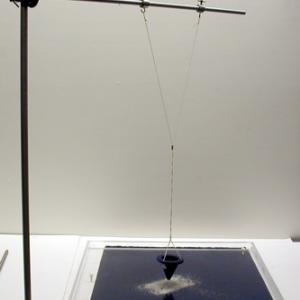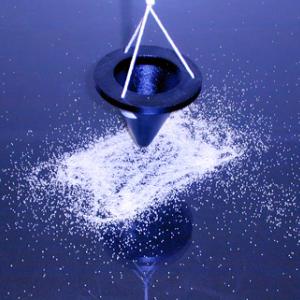College of Liberal Arts & Sciences
3A80.10 - Sand Pendulum
The Sand pendulum is a compound pendulum with two different support points and two different lengths which allow the pendulum to swing in two different planes thus giving Lissajous figures.
The wooden sand pendulum will trace patterns in the sand when the pendulum bob is adjusted to the right height. Consult the instructions for info on how to spread the sand into a concave shape.
- Rand S. Worland, Matthew J. Moelter, "Two -Dimensional Pendulum Experiments Using a Spark Generator", TPT, Vol. 38, # 8, Nov. 2000, p. 489.
- Thomas B. Greenslade, "All About Lissajous Figures", TPT, Vol. 31, # 6, Sept. 1993, p. 364.
- Thomas B. Greenslade, Jr., "The Kaleidophone", TPT, Vol. 30, # 1, p. 38, Jan. 1992.
- Joe Pizzo, "The Sand Pendulum", TPT, Vol. 25, # 4, p. 240, April 1987.
- Edward H. Leonard, "A Whipped-Cream Pendulum", TPT, Vol. 4, # 2, Feb. 1966, p. 84.
- Robert J. Whitaker, "Harmonographs. I. Pendulum Design", AJP, Vol. 69, # 2, p. 162, Feb. 2001.
- Robert J. Whitaker, "Harmonographs. II. Circular Design", AJP, Vol. 69, # 2, p. 174, Feb. 2001.
- Raymond W. Mires and Randall D. Peters, "Motion of a Leaky Pendulum", AJP, Vol. 62, #2, Feb. 1994, p. 137.
- Robert J. Whitaker, "A Note on the Blackburn Pendulum", AJP, 59, # 4, April 1991.
- A. D. Crowell, "Motion of the Earth as Viewed from the Moon and the Y-Suspended Pedulum", AJP, Vol. 49, #5, May. 1981, p. 452.
- Bruce Yeany, "Sand Pendulum", Popular Mechanics, April 2018, p. 104-105.
- Sn-1, 2: Freier and Anderson, A Demonstration Handbook For Physics.
- M-926: "Blackburn's Pendulum", DICK and RAE Physics Demo Notebook.
- Janice VanCleave, "83, Sand Design", Teaching the Fun of Physics, p. 124.
- Janice VanCleave, "22, Curves", Astronomy for Every Kid, p. 50.
- Janice VanCleave, "Curves", 200 Gooey, Slippery, Slimy, Weird, & Fun Experiments, p. 6.
Disclaimer: These demonstrations are provided only for illustrative use by persons affiliated with The University of Iowa and only under the direction of a trained instructor or physicist. The University of Iowa is not responsible for demonstrations performed by those using their own equipment or who choose to use this reference material for their own purpose. The demonstrations included here are within the public domain and can be found in materials contained in libraries, bookstores, and through electronic sources. Performing all or any portion of any of these demonstrations, with or without revisions not depicted here entails inherent risks. These risks include, without limitation, bodily injury (and possibly death), including risks to health that may be temporary or permanent and that may exacerbate a pre-existing medical condition; and property loss or damage. Anyone performing any part of these demonstrations, even with revisions, knowingly and voluntarily assumes all risks associated with them.

